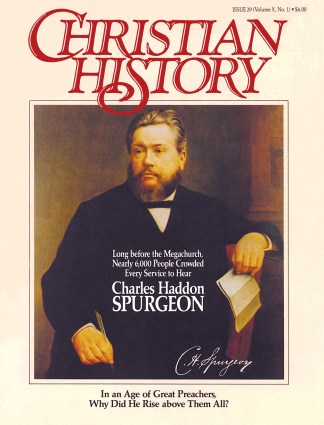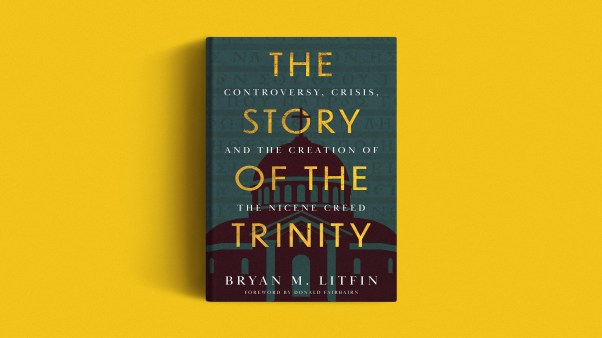London of the 1860s was, to borrow Charles Spurgeon’s expressive humor, “the city of Gog, Magog, and Fog!” Early optimism about the Industrial Revolution was now fading. An urban underclass was growing rapidly. Within this context evangelical Christians struggled with varying degrees of success—to work out the social responsibilities of their faith. Spurgeon declared that he and his congregation were determined “to show our love of truth by truthful love.”
By any standards, the involvement of Spurgeon’s Metropolitan Tabernacle congregation in social ministries was outstanding. In 1867, £23,360 was voluntarily given to the various causes of the church—the Pastors’ College, Almshouses, and the Sunday and Ragged Schools among them. But £7,000 went to one of the most interesting, significant, and least understood of these causes—the Stockwell Orphanage.
A New Enterprise
The summer of 1866 found Spurgeon looking for a new work in which to engage. Concerned about the advances of Tractarianism [a High-Church movement within the Church of England], he wanted to establish a Christian school. An unexpected gift of £20,000 from Anne Hillyard, the widow of an Anglican clergyman, led him in a different direction. By the end of 1867, four boys’ houses had been opened at Stockwell, followed during the 1880s by five houses for girls. Located on the Clapham Road, south of the River Thames, the row of boys’ houses faced a similar row of girls’ houses across an area of lawns and open play areas. Both the boys’ and girls’ institutions aimed to provide for the “free and gratuitous residence, maintenance, clothing, instruction, and education of destitute, fatherless children.”
Spurgeon believed that Christians could cooperate on matters of social concern, when theological differences might exclude cooperation on other issues. At the laying of Stockwell’s foundation stone in 1867 he declared, “On these occasions we do not meet either as Church [of England] people or as Dissenters. When we aim to help orphans or to take care of the poor, we lay aside all that.”
This was not an argument for working with all people who loosely described themselves as Christians. In his later years, as theological liberalism and Christian socialism arose, Spurgeon increasingly put forward the orphanage as a testimony to opponents of the gospel. “The orphanage is an eloquent answer to the sneers of infidels and scoffers of the modern school who would fain make it out that our charity lies in bigoted zeal for doctrines but does not produce practical results. Are any of the new theologians doing more than those of the old orthodox faith? … What does their Socialism amount to beyond words and theory? At any rate, we care for both the bodies and souls of the poor, and try to show our love of truth by truthful love.”
Three Goals for the Orphanage
The annual reports of the orphanage set forth three broad principles for the work.
Need-based admission. The orphanage was to be open to all classes of the community, and patronage from subscribers holding votes was rejected. In this Spurgeon followed the pioneering example of George Müller of Bristol.
Nonsectarian admission. “More concerned that the children should become disciples of Christ than devotees of a sect,” trustees admitted children from any or no denominational background. “No child is prejudiced as a candidate by the creed of his parents.… [If] Christian principles were lacking in the father, the child should not be punished on that account.”
Non-institutionalized care. The Stockwell houses aimed to provide a kinder alternative to the Poor Law workhouses. Much emphasis was placed on locating children in “large families instead of massing them together on the workhouse system.” Spurgeon also determined that children should not endure “this common piece of folly” of being dressed in uniforms.
Goals Realized
To what extent was Spurgeon successful in achieving these aims?
The formal procedure for admitting children rested with a small committee acting on the report of a “messenger.” In establishing this, Spurgeon by and large avoided the abuses of the patronage system. And Spurgeon probably was justified in his frequent claims that children came from all social backgrounds. Farmer, railway worker, customs officer, accountant, clerk, waterman, cabbie, laborer, missionary, shopkeeper, and teacher were among the occupations of deceased fathers. Children from very poor backgrounds, however, tended to be under-represented; and children with a record of ill health or delinquency were generally excluded because “the Institution is not a Hospital, or a Reformatory, or an Idiot Asylum.”
Spurgeon claimed that no child was prejudiced as a candidate by the denominational allegiance of the parents. How far did Spurgeon translate this claim into action? The chart below shows the number of children admitted to Stockwell between 1867 and 1892, according to the religion of their fathers:
| Number | Percent | |
| Church of England | 609 | 38 |
| Baptist | 405 | 25 |
| Congregational | 168 | 11 |
| Methodist | 143 | 9 |
| Presbyterian | 28 | 2 |
| Others | 23 | 2 |
| Unspecified | 200 | 13 |
| TOTAL | 1576 | 100 |
From what we know about religious observance during the period, candidates for Stockwell were slightly more likely to have a denominational tie than were others in society. Baptists were over-represented, and Roman Catholics were under-represented. There is no evidence that the trustees regarded this as a problem. However, in general terms, Spurgeon’s claim of avoiding discrimination is substantially justified by the
Goal Unrealized
However, perhaps the major criticism that can be brought against Stockwell is its failure to realize to any marked degree Spurgeon’s aim of providing substitute family care. Influenced by Wichern’s Rauhe Haus (Ragged House) in Hamburg, Spurgeon planned to provide units of no more than twelve children cared for by a married couple. This combination of residential care and fostering never succeeded for various reasons.
First, there was only a partial commitment to the model. The homes were not physically separate from one another, and single-sex homes were accepted as axiomatic. Children had few of the unspoken rights of childhood. For example, it was agreed by the trustees early in 1869 “that the boys take off their shoes before going upstairs. No boy to go upstairs between morning and night, unless sent up by the Matron.”
Everyday routine was far from easy and was typical of child care of the period. “A bit too spartan life” as people living there at the turn of the century recalled. “With the exception of Sunday, … we arose at 6 a.m. and scrubbed our dormitories, stairs, dining tables and forms, in fact, everything that could be scrubbed, while others peeled potatoes, cleaned boots, etc. ”
Food, recreation, and education were probably no worse and no better than much mainline voluntary care of the period, though the trustees probably exercised a conservative influence in these areas.
Second, there was never any serious attempt to keep the size of the homes as low as twelve. The houses catered to an average of more than forty children, with only two caregivers. The trustees also failed to keep to their decision about staffing the homes, overturning their commitment to having married couples caring for the children. Part of the reason was that the system had been initially “forced upon the Trustees by financial circumstances,” and economic reasons continued to dilute the plan’s effectiveness. Significantly, fostering was rejected because it was “impractical,” not because it was undesirable.
One man recalled his tears on arrival at Stockwell, and “the feeling of bewilderment and utter loneliness that came upon me when I stood within the great playhall.… How strange, too, and unlike anything I had ever known before, the dining room seemed, with its long tables, spread with row after row of mugs and slices of bread and butter; and the dormitories, neat, clean and comfortable, but so different to the little bedroom I had been accustomed to at home.”
Spurgeon insisted that “the children are not dressed in a uniform to mark them as recipients of charity.” In words of continuing relevance he argued just three years before his death that “orphanhood is a child’s misfortune, and should not be treated as though it were his fault. In a garb which is a symbol of dependence it is difficult, if not impossible, for an orphan to preserve a feeling of self-respect. ”
However, uniformity of dress did tend to emerge. In an illuminating entry in the Master’s Report Book in 1882, Vernon Charlesworth, the head of the establishment, wrote, “With regard to the dress of the children the president’s wish has been regarded and we have striven to avoid the monotony of an institution badge.” Charlesworth had originally written, “We have avoided the monotony of … ” but deleted this in favor of the significantly weaker statement. As this illustrates, an ad hoc pattern of rule making dominated Stockwell’s formative years and diluted the principles upon which the work was founded.
Insights from the Orphanages
Spurgeon did not set out to innovate. He failed to develop a radical critique of contemporary orphanage practice. His opposition to the voting system (a common practice in which an orphan was admitted upon the votes of wealthy subscribers) is a case in point. Unlike George Müller, who was writing on this in the 1830s, Spurgeon refused to press for its general abolition. The fact that at least one of his deacons held votes for another orphanage must have influenced him at this point.
Further, the trustees often showed themselves oddly out of touch. Charlesworth, with Spurgeon’s backing, carried out a running battle with the trustees for a decent asphalt surface; the existing one was either black dust or semi-liquid paste according to the weather. An unknown trustee had added the almost incredible note in the margin of the Master’s Report Book, “Master to use the blacking for Boys’ boots!”
And paternalism and sentimentality were too often present. “This great Hostelry of the All Merciful” was scarcely a description with which Stockwell’s residents would concur.
However, the value of Spurgeon’s initiatives should not be underestimated. His realization that social work carried out in the name of Christianity must be articulated with the doctrine of salvation was important at a time when liberal criticism was growing and evangelicalism was in decline.
Spurgeon’s insistence that admission should be on the basis of need—not limited by social background or religious allegiance—set an example that is ever relevant.
Above all, Spurgeon’s social ministries reveal the possibilities of powerful preaching. It was his preaching of the doctrines of grace that drew a congregation that could finance an operation of this scale almost single-handedly. And in changed form, Spurgeon’s Homes still provide a child-care service today.
Copyright by the author or Christianity Today/Christian History magazine. Click here for reprint information on Christian History.










